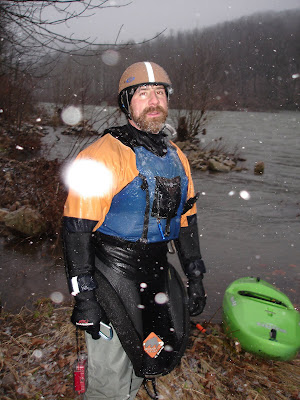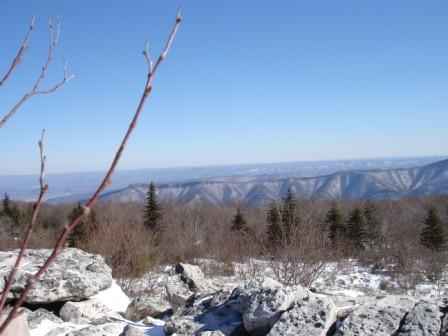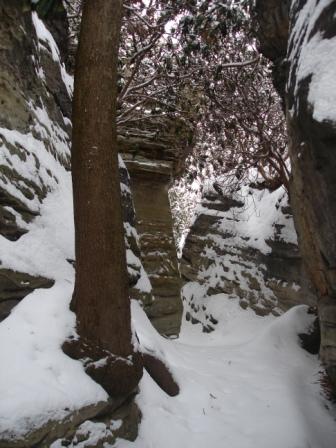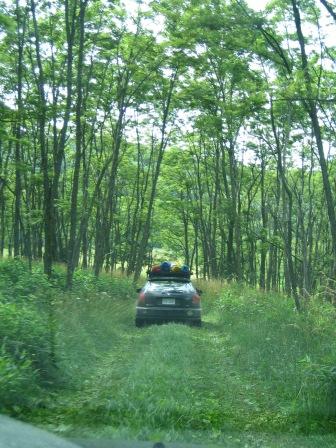
This weekend I spent the days on PA rivers. My trip report from Got Boof from a dramatic Sunday on Indian Creek is reprinted here:
The elation associated with seeing my friend Mike ashore, grinning and arms waving, was significant enough to allow me – for a moment – to forget about my physical discomforts. The soreness in my back from paddling as swiftly as possible for five miles and the numbness in my fingers, the stinging on my face, and the shivering in my core from doing so in sub-freezing temperatures into a strong headwind were overtaken by relief. Mike was literally and figuratively out of the woods and this meant that we would not be faced with the prospect of beginning a search for him there in these conditions.
We started the day with a plethora of prospects, but needed to be on the safe side. It had rained enough overnight to bring up some of the gauges and because Mike is a beginning paddler, the options were a bit more limited. After toying around with the idea of the Casselman River (too high), Laurel Hill Creek (probably our safest bet), and Indian Creek (just a bit of a challenge for Mike), we opted for the latter because it came with the addition of our friend Jason, who would add 33.3% more safety on the water. That seemed to make Laurel Hill Creek a less desirable option, and as we found out later, that was actually a 50% increase because our friend Art came along as well. Indian Creek it was. Grease Fire did his best Indian impression, though I'm not certain that any American Indian actually ever repeatedly hit his or her mouth with their hand while making a loud "O" sound.
Indian Creek at the level we found it yesterday is a lot like the Lower Yough with the addition of two 6-foot ledge drops that excited the experienced paddlers in the group (Art, Jason, "Grease Fire" Rob, and me) and challenged Mike to experiment with a boof stroke. His first experiment failed, and after a short sideways ride in a curtain, Mike swam out of his boat. Strike one. In general, few holes on Indian Creek were not punch-worthy, but Mike found one of these a short time after his first swim. Strike two. In fact, after swimming out of this hole, his boat found itself abandoned for the first time that day on a mid-river ledge. No fear; Indiana Jones brought his whip. Cue in the theme music.
With Mike's third swim came his third strike. All agreed it was time to walk. Because we were more than halfway down the Indian, he would walk downstream. When he reached the confluence with the Yough, we would all paddle the flatwater five miles to the take out. The wrench in the plan came about 30 minutes later when Jason and I realized that there are two un-crossable tributaries before that, Rasler and Richter Run. It was at that moment that I became unnerved with the situation, and so when we got to Rasler Run, I insisted on hiking up to find Mike. Also at that moment, Mother Nature chimed in with her interesting twist: a snowstorm.
And so I spent the next 90 minutes (wild guess here; no watches in the group) hiking up and down Rasler on both sides trying to locate Mike. Blowing my whistle and shouting was unsuccessful as I crawled on all fours against the cold ground through thick rhododendron. Grease Fire waited at the confluence and eventually huddled under a thick patch of rhododendron to stay warm. Art and Jason hiked up Rasler with their boats for about ¾ of a mile and paddled the class 5 creek back down. When we reunited at the small creek's end, we decided that the situation was now urgent enough to make our main priority getting to Mike. And, he had to be somewhere between Rasler and the put in, an area we were now unable to adequately search because we were downstream of it.
The beauty of shoving our kayaks back into Indian Creek with big, heavy flakes dropping was barely noticed as we all pushed on. As we approached AW-rated class 5 Terminator rapid, I bowed to the River Gods and asked for kindness. We scouted, and all ran the big Upper Gauley-esque wavetrain with no issues. In a rapid below that, Rob was surfed sideways into a big hole. As we all reacted by turning around to help, Jason was closest to him. Rob wrestled with the hydraulic for a 20-second ride, was flipped, and then surfed himself out the side of the ugly hole. Upon reaching Jason, he sternly said, "We don't have time for a swimmer." Cue up that theme music one more time.
The day was clearly getting late when we reach the mighty Yough. Looking more like the Ohio, the river was more than 100 yards wide and the wind was whipping whitecaps into showers of spray. A plan was initiated, though I think that it was probably slightly different in each of our heads. In mine, it was as follows. I would paddle hard with keys to one of the take out vehicles, warm it up and get changed into dry clothes. That would allow me to load boats onto the roofs while the others changed and warmed up. Once we were ready to move, one car would go straight to the put in vehicle, hoping to find Mike there. The other car, equipped with a Gazetteer, would take a detour and explore the back roads on the upstream side of Rasler Run, hoping to find Mike there. We'd meet at the put-in car, where there was food, and if we didn't have Mike with us by then, one car would stay there and wait while the other drove to the Fire Department in Ohiopyle (about 5 miles away) to get help. It was very cold out and the snow was piling up. Mike would not make it through the night if he was in the woods in all of his wet paddling gear. I was concerned to the point that I'd accepted the necessity of spending whatever money was necessary to get the four of us geared up to hike into the woods for many hours in these conditions at night. I was putting together a mental list of gear for each of the four of us: headlamp, extra batteries, sturdy boots, outerwear, thermos with hot tea, food, blankets, etc.
It was only a week ago that a few acquaintances had been lost in the woods of the Otter Creek Wilderness in West Virginia after an unsuccessful attempted first "complete" descent of Moore Run. There were only two of them and one spent the night in the woods after suffering a broken nose and serious lacerations on his face, both of which occurred during a bad swim after the two men had separated from each other on the river. It all turned out well, but the night was in the low 40's and it was dry. With the weather into which I was now paddling, the situation that I was now envisioning was potentially deadly for Mike.
Mike's solo landborne experience was not psychologically dissimilar from ours, and he made all the right decisions. Upon reaching Rasler Run, he discounted getting in his boat or attempting to wade across. Rather, he remembered us showing him a secondary road that goes to its put in. So, he quickly and smartly diverted his downstream journey along Indian Creek into an upstream journey along Rasler Run. Ducking the thick rhododendron underbrush on all fours in the snow, Mike dragged his heavy kayak behind him for what mush have seemed like an eternity. We could have been separated by only a few hundred yards at that time and wouldn't have known it. The heavy load undoubtedly kept Mike working hard enough that he was warm, but that also meant that he was expending a lot of energy he would need if he was stuck overnight. But, he didn't need it, because there was NO WAY he was getting stuck overnight; it would be fatal. Mike soldiered on to a backroad, and in his own words, knew that he would be fine. He picked up his boat and followed the road uphill out of the creek's drainage region. Miles later, exhausted, he got to the main road, Rt. 381, dropped his boat in a ditch, and earned his new nickname: Hitch. His approximation of the time spent hitch hiking is 90 minutes. It was now in the 20's, approaching darkness, and the snow was creating near whiteout conditions. Mike must have been equally as afraid of a car sliding into him as he was of one never stopping for him. When he was finally picked up, he had no idea where to go. As a new paddler who lives 4 hours from this area, he is not familiar with the region. After he and the driver quizzed each other on nearby towns and waterways, the conclusion was drawn that he would find us at out take out near the Rod & Gun Club in Connellsville. The man drove him out of his way for more than ten miles through the big storm. Insert divine intervention reference here.
And so another epic day on the river came to a shivering end, with the five of us screaming and hugging, celebrating there on the side of the Yough just upstream of Connellsvile. Ice coated all of our skirts, helmets, and life jackets. Mike was now cold enough to be going into high frequency vibration. Cars were started, warmth returned, and the long, slippery drive home began. Ironically, the question "Got Boof?", had it been posed to Mike before launching into Indian Creek and pondered seriously, would have radically changed the course of the day.



































